
 Nick Pelios
Freediver, Creator
Nick Pelios
Freediver, Creator

 Nick Pelios
Freediver, Creator
Nick Pelios
Freediver, Creator
Every freediver knows the feeling of a dive that went “pretty well.” You come back to the surface, do your recovery breaths, nod to your buddy, and rest in the glow of silence. You felt streamlined. Your duck-dive was smooth. Equalization was easy. That’s what you tell yourself. But when you watch the footage later, your fin stroke was uneven, your free-fall posture was crooked, and your left hand instinctively reached for the lanyard like it does every single time.
Filming your dives does not make you a narcissist. It makes you a student. It is not about turning your breath hold into a social media moment. It is about studying the mechanics of your movement, your body language underwater, and your relationship with depth. It gives you what no coach or dive log ever could: a permanent mirror placed in front of your technique.
This is especially useful in a sport where almost everything happens in silence, beneath the surface, and inside your own body. A freediving session, even with a buddy watching from above, is largely experienced alone. You feel relaxed but your body tells a different story. You think you dropped into free-fall early but the footage shows you were still finning at 20 meters. You were sure you executed a clean duck-dive but you can see bubbles escaping your mask on every entry. These are not failures. They are invitations.
When you film your dives, you begin to understand that freediving is not just about being calm. It is about being consistent. And the camera sees the inconsistencies that your breath can’t always feel.
You may also notice things that have nothing to do with performance. The way your fin blades disturb sand at the bottom. The startled jolt of a fish that swam too close. The tiny clumps of algae that you brushed with your shoulder during ascent. These details make you aware of your place in the ecosystem. They remind you that every action leaves a trace. And when you replay that trace, frame by frame, it’s harder to excuse the moments where you were careless.
What the camera records is not just posture and power. It records presence. It teaches humility.
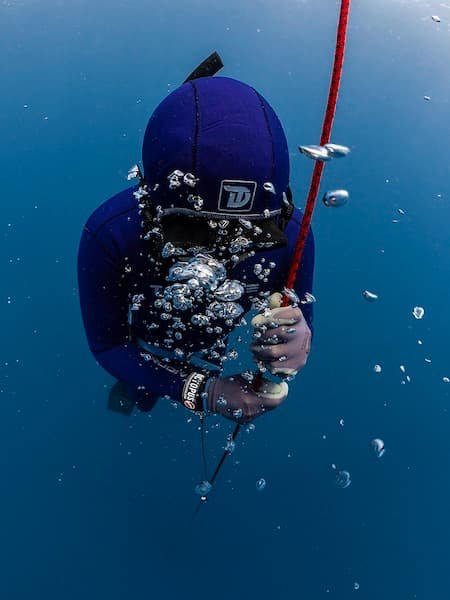
Every good training session begins with intention. You do your warm-ups, visualize your dive, check your gear, descend. But the problem is, freediving is a sport of internal feedback. You don’t hear a coach yelling instructions from the sidelines. You feel your diaphragm contracting, your lungs compressing, your ears clearing. If something goes wrong, you troubleshoot through feeling. But what if your feeling is wrong?
Many common mistakes in freediving go unnoticed without video. These include asymmetrical kicking, over-bending at the hips, early mouthfill, bent knees during free-fall, and late recovery breaths. These mistakes are often small, and they don’t always lead to dangerous outcomes. But over time, they reduce your efficiency and increase your oxygen consumption. Left uncorrected, they become habits.
Video lets you pause your descent at 5-meter intervals and look at your posture. Is your head aligned with your spine? Are your arms tucked in or flaring out? Are your feet finishing the kick or are they trailing behind? Are your ankles relaxed or flexed? These questions may sound minor, but in a sport where every gram of drag and every wasted motion matters, they make a difference.
It is also important to film your surface routine. Most people assume the dive begins when they leave the surface. But it begins before that, with your last few breaths. Are you breathing calmly or with tension? Is your final inhale full or rushed? Are you pulling the snorkel out with intention or as an afterthought? What is your face doing in those last seconds before the dive? These details can shape the psychological tone of the dive. They matter.
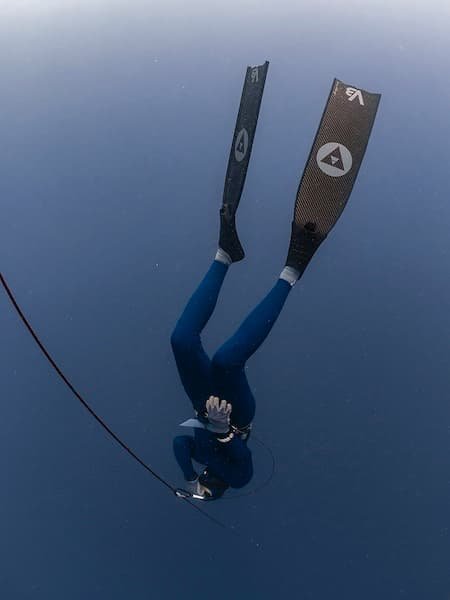
The same applies to the ascent. Once the free-fall ends and you begin kicking back to the surface, form starts to deteriorate. Legs tire, core collapses, stroke rhythm falters. A video of your ascent can reveal whether you are finishing strong or barely holding it together. Watching that can motivate you to improve your exit strategy, to stay sharp all the way to the surface rather than mentally checking out once you see the sun above.
If you want to use video to improve performance, don’t film just for the sake of capturing the whole dive. Break it down. Focus on one element per session. Maybe this week you’re studying your duck-dive. Next week, your free-fall posture. After that, the timing of your mouthfill. Narrow focus leads to better feedback. You are not filming a documentary. You are recording lessons.
You do not need high-end gear. A basic action camera in 1080p or 4K, secured to your buoy, the bottom plate, your mask, or your buddy’s hand, will work. Ideally, use different angles. A side profile reveals more about your body position than a mask-mounted camera. If you want to analyze technique, avoid shaky footage. If you want to tell a story, capture emotion. Both have value.
Keep your clips short. Label and organize them. Rewatch them at the end of every week. You will begin to see patterns. Some are good. Others are not. But all of them will be yours to change.
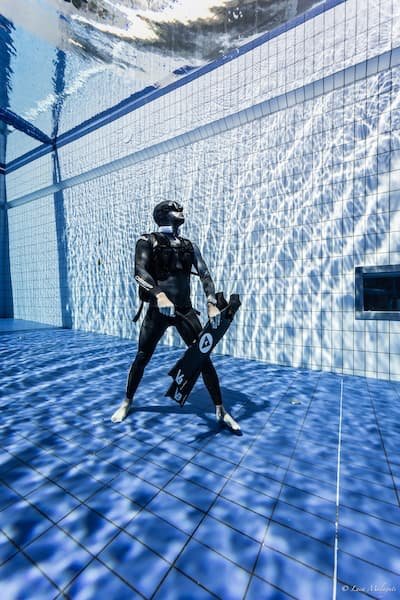
In the age of content, filming yourself underwater can feel performative. And for some, it is. The ocean becomes a backdrop. The dive becomes an aesthetic. That’s not always wrong. But it misses the deeper opportunity. Filming should serve the diver, not the audience.
When used properly, video strengthens your connection with the environment. Not just because you can see what you disturbed, but because you are forced to watch it later. The dust you kicked up on the reef is no longer hypothetical. It’s right there on your screen. The octopus you startled with your fins did not need your attention. But now it has it.
In reviewing your footage, you begin to see yourself not as a solo athlete but as one part of a much larger system. You start kicking less. Hovering more. Approaching slowly. Avoiding contact. The camera, when paired with conscience, turns you into a more respectful diver.
At the same time, it’s important to film ethically. Don’t record other divers without asking. If someone else is in frame, especially during a training dive or depth session, make sure they’re comfortable being included. Just because someone trained next to you doesn’t mean they want to be featured on your Instagram.
The same goes for location. When posting your dives online, avoid geotagging sensitive sites. Not every coral reef needs a GPS pin. Crowds follow maps, and maps are created with the best of intentions and the worst of consequences. If you find a spot that feels magical, protect it. You can share the story without giving away the address.
And when you do share a clip, ask yourself why. Is it to educate? To celebrate? To confess? To inspire? All are valid. Just make sure it’s not only to impress.
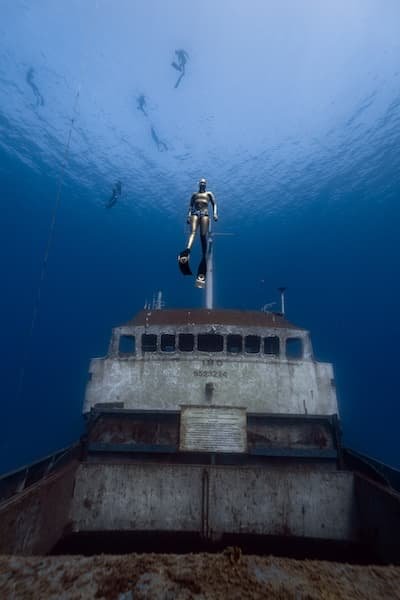
There’s a kind of clarity that only video can offer. The moment you press play and watch yourself underwater, the story you’ve been telling about how that dive went begins to unravel. That’s not a bad thing. It’s a kind of honesty that the ocean itself invites.
You thought your legs were strong. They were shaking. You thought you were gliding. You were falling out of alignment. You thought your recovery was clean. You skipped the first breath.
That sting of correction is what growth feels like.
And then, sometimes, you notice something beautiful. A perfectly timed transition into free-fall. A moment of stillness at the bottom where your fins hovered just above the sand. A kick stroke that looked exactly the way it felt: powerful and efficient.
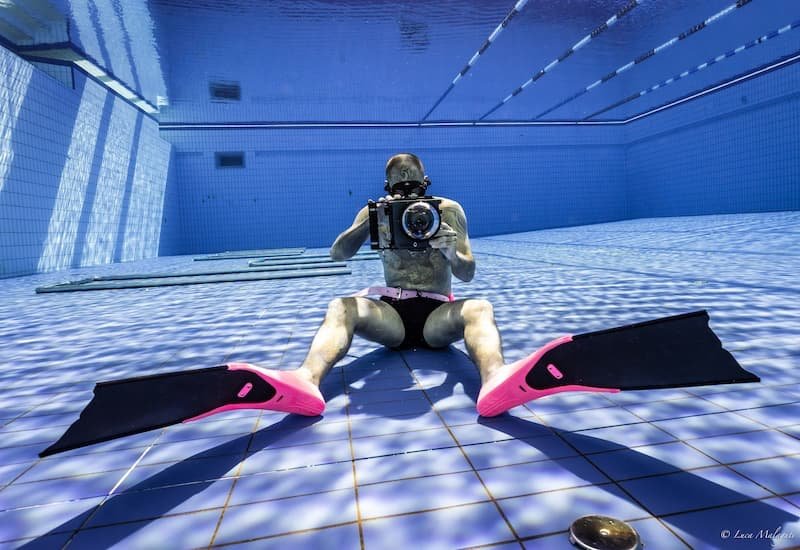
These are the reasons to film. Not to flatter yourself. Not to turn every dive into a highlight reel. But to understand what really happened, so you can do it again, or avoid it, or improve it.
In time, the camera becomes something more than a tool. It becomes a companion. A record keeper. A storyteller.
Some divers choose not to film at all. They prefer to remember. That is valid too. But for those who want to go deeper, not just in meters, but in understanding, filming is a gift. It brings you closer to your own truth. It shows you the parts you miss. And it teaches you to be a better diver, not just through feeling, but through seeing.
If you want to grow, film your dives. Study them. Reflect on them. Keep the clips to yourself if you want. Or share them wisely. Either way, the reward is the same: a fuller picture of who you are in the water.
And that, more than depth or time or distance, is what makes you a freediver.